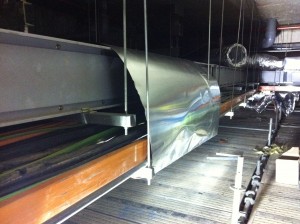Center for High Resolution Instruments for Science
We designed and constructed one of the best noise free laboratories in the world, a “quiet island” inside the School of Physical and Mathematical Sciences at the Nanyang Technological University, in Singapore. You can see a short animation of the facility here and below:
Our laboratory is mechanically and acoustically isolated using a complex superposition of several isolation stages described below. We also took good care of the electromagnetic radiation and magnetic field isolation.
The video shown below demonstrates the development and completion of the main laboratory structure:
Mechanical isolation
In order to achieve a floor displacement of 10nm peak to peak we have involved tremendous construction work. The floor has first been excavated down to 5 meters below the ground. Then 11 piles, each of them 25 meters long, have been drilled and filled up with concrete to ensure that our foundation is sitting on the first hard rock layer of Singapore, the « Jurong formation ».
The 200 tonnes foundation sits on the 11 piles and is completely disconnected from the rest of the building. This first important mass of concrete has a resonance frequency of 50Hz and acts as a first isolation to any kind of vibration coming from the ground.
On top of the foundation, we are installing two lines of four air isolators. These isolators are 1.65 meters wide and 1.6 meters tall. Each can carry 44 tons and have a resonance frequency of 0.75Hz. This second stage of isolation is a key component of our construction.
The final slab, built in a T-shape to lower as much as possible its centre of gravity, will float on top of the eight isolators. The floating slab weighs 350 tonnes (with wall, ceiling, crane and instrument). The energy necessary to move such a massive slab is so high that the slab itself acts as a third stage of isolation.
The fourth and fifth stage of isolation are dedicated to the dilution fridge. A torus shape 7 tonnes slab sits on 6 active piezoelectric vibration cancellation system which have an electric noise vibration level of 0.1nm RMS. Finally, four overdamped isolators sits on the torus slab and hold the dilution fridge.
Acoustical isolation and treatment on penetration
All pipes running over the laboratory have been wrapped up with rock wool and boxed up. The entire laboratory is built with brick wall to ensure a good acoustic noise cancellation. The walls and ceiling of the floating slab are also treated with rock wool to reduce the noise coming from the laboratory itself.
In every vibration free laboratory project, one of the most difficult part to deal with is always the different penetration/services. Of course, our floating slab does not have any type of air conditioning, but electrical penetration, cooling water, gases and vacuum lines are always a challenge to mechanically decouple from the slab.
We have designed and custom made a highly flexible copper braid connector to bring electricity to our laboratory, gas pipes and chilled water pipes are going trough our brick wall wrapped up in a thick layer of rubber.
The main source of vibration in our laboratory is definitely the vacuum pumps. Therefore we have built a pump room, which is entirely disconnected from the rest of the building and from the rest of the laboratory. Each set of pump is built on a fairly simple and relatively small floating slab and each vacuum line is mechanically isolated using simple active vibration isolators. Our vacuum pipes are sunk in the floating slab of the laboratory to transmit as much residual vibration to the laboratory instead of transmitting it directly to the dilution fridge. Highly flexible bellows are connecting the pipes from the pump room to the pipes sunk in the concrete of the floating slab.
Electromagnetic radiation and magnetic field isolation
All the electrical cables and bus bars running over the laboratory are all RF shielded by 3 layers of 0.3mm aluminium sheet and 3 layers of heavy duty aluminium sheets (0.033mm).
All electrical trunking in the laboratory are made out of aluminium and each power point is boxed up in a custom made aluminium box to ensure a constant RF shielding around all electrical cables.
To ensure a good quality in our measurement, the floating slab is entirely shielded using two layers of mu-copper wall paper. The two sliding doors of the floating slab are also mu-copper shielded and heavily acoustically shielded. Each electrical penetration is also shielded using special RF filters.
Hunting strongly-correlated electrons with the nanoTIGER
The nanoTIGER (NanoTechnology In Global Expansion Race) is part of the Center for High Resolution Instruments for Science and forms a complete system for the growth, imaging, manipulation and analysis of novel materials within a single ultra-high vacuum (UHV) space.
Growth
The system has been configured with several unique growth and deposition facilities. Our principal growth chamber is equipped with a home-built RF magnetron sputtering system, designed for slow growth rates at very low pressures. Co-deposition from two separate sources is possible (with room for expansion up to 5 sources, in normal or co-planar configurations). A quad-source UHV evaporator is also present in this chamber.
We have designed a variable-temperature rotating sample holder, capable of operation from below 20K to above 800K while maintaining multiple electrical contacts to the sample during continuous rotation. In this way, we may accurately regulate our substrate temperature during growth, thus controlling the degree of disorder in our deposited films. Simple in situ electrical characterization may take place during or after growth, before the freshly-grown sample is transferred under vacuum to our Imaging or Analysis chambers.
We can also perform measurements on externally-grown materials, which are introduced through a load-lock before being cleaved in-situ at any temperature from 300K to below 20K. An argon ion gun is available in our growth chamber for sample cleaning if necessary. We may also “write” nanostructures onto any films or crystals using a gas injection system (GIS) in our focussed ion/electron beam chamber.
Imaging and Manipulation
The experimental suite includes atomic-resolution local probe microscopes for topographical measurements. Although it is often useful to rapidly acquire a large-scale image of a sample surface, even more useful is the ability to locally modify the surface topology to create nanostructures, either by nano-machining using a focused ion beam (FIB) or by nano-deposition using a GIS together with a focused electron beam (FEB). To this end, one of the experimental chambers features a 2.5nm resolution FIB and a 4nm resolution FEB in crossbeam configuration (together with a secondary electron detector) for simultaneous imaging and machining. A low-energy electron flood gun is also included, for FIB-milling insulating samples. The entire vacuum chamber is fabricated from Mumetal to ensure adequate magnetic shielding for both beams.
Helium beams represent the future in focused ion technology and promise great improvements in spatial resolution for nano-machining. We have left free space in our chamber and an access flange for a helium ion column and hope to incorporate one of these instruments into our system as soon as this becomes possible. One of our scientific aims is to use this equipment to create true nanoscale superconducting quantum interference devices.
Analysis
Further to a set of local magnetotransport and thermodynamic experiments operating from room temperature down to 10mK, in magnetic fields up to 17T, our system will be capable of employing a range of home-built scanning probe microscopy techniques. For this, we have developed a low noise dilution refrigerator within an ultra-low-loss cryostat. Both the refrigerator and cryostat are made entirely from non-magnetic materials and externally shielded by Mumetal. In this way, we ensure that while measuring at high magnetic fields, other instruments in the lab will remain unaffected. We are also able to achieve true zero field conditions if so required by our experiments.
In the case of microscopic studies, inside the sample-change chamber above the cryostat, an 8nm resolution FEB enables us to accurately position our microscope tip above nanoscale surface features. The entire microscope head unit travels from the sample-change chamber down to its cold receptacle, located over 2m below at the magnetic field centre, thus facilitating maintenance.








